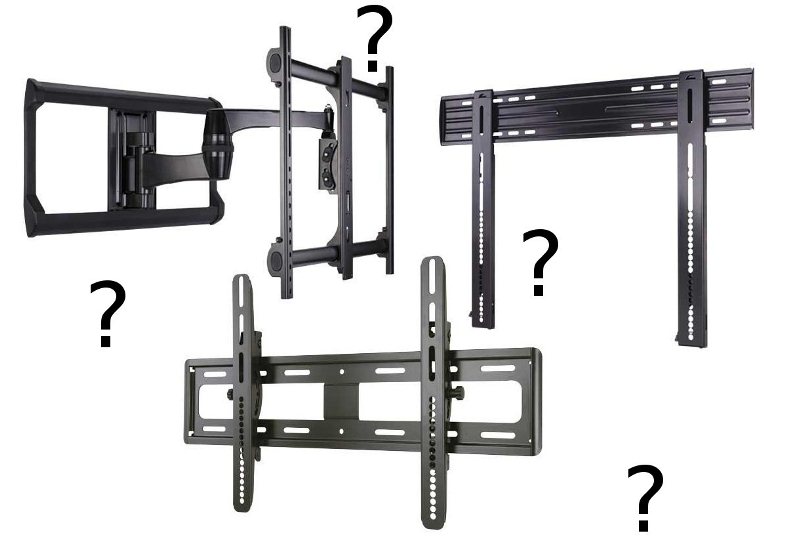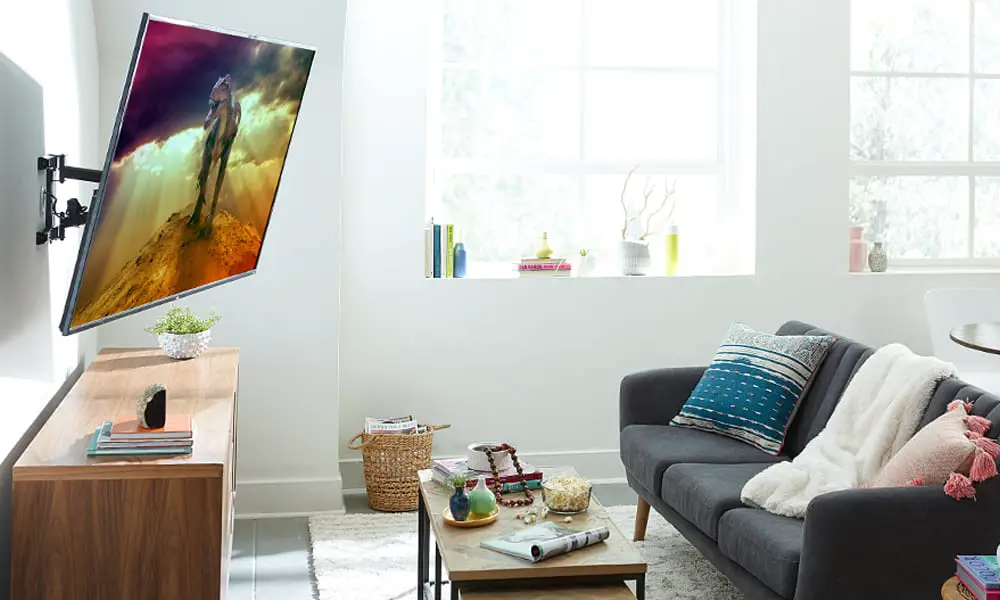One of the great things about owning a camper is that you get to take a little piece of home with you when you are on the road. Campers are the preferred travel method of nearly 11.2 million people nationwide. Because home features are such a drawing factor for campers, it is quite common for TVs to be installed in them.
In this article, you will learn about the materials you need to properly install a TV in a camper, as well as the necessary steps to follow to get your TV up and working.

How do You Install a TV in a Camper?
When you set out to install a TV in your camper, you need to remember the size of your camper will dictate the size and type of TV you choose to install. While a large TV may fit into space you have, if the camper wall cannot adequately support it, you may cause unnecessary damage to the camper.
Accurate measurements of the space and an understanding of the support you must anchor your TV too, are critical before you begin your install project.
Related Articles: Can You Watch TV in an RV While Driving? How to Power a TV in a Van: The Complete Guide
Planning

Setting out to complete any construction task requires a plan. At first glance, it may appear that installing a TV into a camper is quite a simple project. Think again! Although installing a TV in your camper is quite easy to do, if you miscalculate the size and necessary supports, you could find yourself in a bit of trouble.
When planning, you need to think about these things; Install space, mount types, size of the TV, Supports.
Install Space: It is important that you correctly measure the space where you will install the TV. When measuring the space, you will want to pay close attention to the height and width of the space, also taking the height of the mounting bracket.
Some campers have specially built-in shelves for TVs. You will need to see if this shelf works or if you are going to use a mounting bracket of sorts.

Mount Types: While mounting tv into a camper is not a tough task, you need to understand the types of mounts you can purchase. You will find five styles of mounts:
- Flat-panel
- Articulation
- Full motion
- Under cabinet
- Pull down.
The style of mount you choose will be dictated by the space you have to install the TV. You need to pay close attention to the clearance needed for the mount once it has been installed.
Size of TV: Choosing the correct size TV is important when you begin the process. While it may be tempting to get a large screen TV, you need to make sure it will safely fit in the space you have. If you try to install a TV that is too large, it will not be able to be properly secured to the camper and could pose a safety risk.
Supports: Part of choosing the correct size of TV depends on the availability of support studs in the camper. To find out where the studs are located, you can use the palm of your hand or a stud finder, which will be much more accurate than your hand. Because of the potential weight of the TV, you want to be as accurate as possible.
Gather Your Materials
Once you have planned out the size of your space, proper brackets, and take measurements to ensure you are installing a TV that will safely remain intact, you are ready to gather the necessary materials to begin your project.
Materials you will need:
- TV Mount
- Heavy Duty Drill
- Multiple Drill Bits
- Stud Finder
- Extra Cables
- Measuring Tape
- Level
Using the materials above, you will likely install a TV in your RV easily and efficiently. Depending on the size of the TV, you may need to have someone help you as you place it onto the mount. The last thing you want to do is drop your TV.
TV Mount

When choosing your TV Mount, you need to make sure you have the proper fit and a gauge to hold the TV you are preparing to hang. It is recommended that you purchase an amount that is a bit heavier in gauge than required. A heavier mount will help ensure that your TV stays securely fixed in the camper.
Heavy Duty Drill
It would be best if you had a drill that will penetrate the material where you will be anchoring your TV mount. While most standard drills will likely suffice, being proactive with a strong drill will help do the job that much easier to complete.
Multiple Drill Bits
Different TV mounts will have different-sized holes for you to attach the screws to the studs. Because of this, it would serve you well to have a variety of drill bit sizes. There is nothing more frustrating than finding out halfway through a project that you cannot complete because you do not have the proper tools. With multiple-sized drill bits, you will likely be able to complete the project with ease.
Stud Finder
This tool is possibly one of the most useful yet underrated tools you can have in your arsenal. You can likely find the studs by knocking on the wall or pressing with the palm of your hand. You can try this strategy in your camper; however, it may be difficult because of the materials that make up the camper’s body.
Using a stud finder ensures that you are locating studs that will support the added weight of both the TV and mount. If you attempt to position the mount where there is no stud, your TV can easily fall from the wall.
Extra Cables
You may be thinking your TV already has cables. While this is true, your TV has likely never been mounted to a wall or an arm. Because of the difference in mounting, you may find that you need to use longer cables to hook your TV into the wall and power source appropriately.
Instead of waiting until the mount is up and the TV is hanging, it would be helpful to have extra cables in different lengths available, so you can complete the job without making trips to the store. The good news is that you can return any unused cables without much of a hassle. Make sure you check return policies before purchasing all your extra cables to ensure an easy return.
Measuring Tape
Whenever you start construction or a hanging type of project, you want to make sure you have a quality tape measure on hand. You do not want to “eyeball” the process of hanging a TV in your camper. A measuring tape will help you with the correct placement.
Level
A level will come in handy as you begin to drill holes to hang the mount on the wall. As you are marking the wall to drill, you will want to line the level up to make sure the bracket is being attached in a way that will allow the TV to sit straight. Having a crooked TV in your camper would be no fun.
The materials above are quite standard when it comes to installing a TV in your camper. There may be other things you wish to add to your list of tools as a personal preference. However, minimal tools will get the job done.
Prepare the Camper to mount your TV
Once you have gathered all your materials, you are ready to begin the process of preparing for your install. To do this, you will want to find the exact location in your camper where you will be installing the TV. Check to see where the connections are as well as the power source needed for your TV.
You will also want to see if there is a premade TV shelf in the camper. Sometimes you can use this as a frame for your TV, but other times you may need to remove the frame if it does not accommodate the size of the TV you are planning to install.
Note: If you find yourself getting ready to remove something built into the camper, you need to make sure it is not critical to the structure’s support. Likely, a TV shelf would not do much for the structure, but it is important to ask an expert when in doubt. Asking will ensure that you do not harm the integrity of your camper.
Install the TV Mounts
This step is the most important of the entire process. In this step, you will be affixing the bracket to your camper that will be responsible for holding the weight of the TV you are installing. Because of this, you want to take your time and make sure it is correctly installed.
- Measure the area you are planning to install the TV in and get the exact measurement of your TV and mount. Be sure to account for any additional height or width from the mount’s movement, such as an extending or articulating arm.
- Use your stud finder to determine where the studs are on the wall.
- Mark the studs with a pencil, so you have a point of reference to hang the mount.
- Most mounts come with a template that helps you correctly position the holes for mounting. Use this to determine where exactly you will need to drill. To help affix the template to the wall, you can use painter’s tape. Using this trick will help ensure the template stays level.
- Drill the holes where they need to be.
- Begin attaching the mount to the wall. It is wise to screw the mount only lightly with minimal screws to ensure that it is fully level. You can do this by using your level once it is partially attached.
Attach the TV in your RV
Once the mount is fully attached, you are ready to hook the TV to the mount. When you put the TV on the mount, you need to use caution to make sure you do not damage the mount or your TV. After the TV is fully connected, you are ready to hook it to the power source to test it out.
As you hook it to the power source, make sure the cables fall easily behind the TV and have some slack, so you are not unnecessarily adding stress to the TV and cables by pulling them. If you find they are too short, you must switch them out. Once the cables are installed, you may also wish to put a cable cover over the cords to provide a more finished look.
Test the TV
As with anything, you want to make sure you test it out before putting all the tools away. A TV in your camper is no different. To test it out, make sure it is connected fully to a power source to ensure your connection works.
The next thing you want to test is stability. Make sure the TV is not able to bounce or jostle around. If it can bounce and move, you will likely have a problem once you take the camper on the road. To help eliminate problematic movement, you may need to attach alternative brackets to the TV to hold it in place. Using additional brackets will be much easier if the TV is not on a mobile mount.
Installation common Problems and solutions
While it would be nice to imagine everything will go perfect with installing a TV in your camper, there is always room for error, like it or not. Here are some of the common problems you may face:
| Problem | Solution |
| Bending mount | If the mount is bending when you attach the TV to it, you have likely purchased the incorrect size mount for your TV. To remedy this, you will need to return to the store or online site you purchased the mount from and find the next larger size. Sometimes the size of the mount is fine. However, the mount may not be made of heavy material to support the added weight of the TV. Going up to the next gauge of metal will likely help. |
| No TV Reception | Depending on the method of reception you are using, you may need to move the antenna or adjust your cables attached to the TV. If you are camping in a heavily wooded area, it is unlikely that your antennae will work very well. In this case, you may need to come up with some alternative ways to get reception. |
| No Studs | It is unlikely that you will run into the problem of no studs, but if you do, there are some options for you. You can find a stud in the ceiling and use a ceiling mount. It is important to know that a ceiling mount will only work if you can tilt your TV. Another option would be to create your stud by securing a beam across the area you wish to attach the TV. Creating your connection point is not an ideal option because it is not as secure as the studs in the camper, but it would work at least temporarily in a pinch. |
Cost for a well secured TV installation in your RV
Mounting a TV in your camper does not have to be an expensive venture. However, you do want to make sure you purchase a quality mount. Remember, this mount is going to be bounced each time you take the camper on the road. Without a secure and quality mount, you are running the risk of damage to your TV and camper.
You can anticipate spending $24 – $250 for a TV mount, depending on the features you would like to have. The size of the TV you are mounting will also play a part in the amount you will need to spend. If you do not want to spend a fortune, it is typically best to look at a mid-range price. Usually, you will find a quality piece of equipment that will serve its purpose well, and you will not break the bank.
Can You Use a Regular TV Mount in an RV?

As you are looking for mounts to install in your RV, you may be wondering if an in home mount will do the trick. The good news is, yes, it will, but you need to take the proper precautions if you choose to use this type of mount. If you have ever installed a TV mount in your home, you will notice that the majority of the mounts move or swivel.
While stationary in a home, a swivel mount is completely safe and functional. If you choose to put this type of mount into your RV, it could be problematic if not handled correctly. The concern is with the movement of the RV on trips. If the TV is able to swivel, it will likely be moving around during the trip, which could cause damage to either your TV or RV. To remedy this, you may need to remove the TV during travel or find a way to secure the mount so it cannot swivel.
Final Thoughts
Securing a TV in your camper can help provide entertainment for your family while you are on vacation, and it does not have to be a huge undertaking. Before beginning, make sure you purchase the proper mounting equipment and have the correct tools on hand. Not only will this make the installation more efficient, but it will also help prevent mishaps that could occur. So grab your tools and the most sturdy mount you can find and get that TV into the camper.
